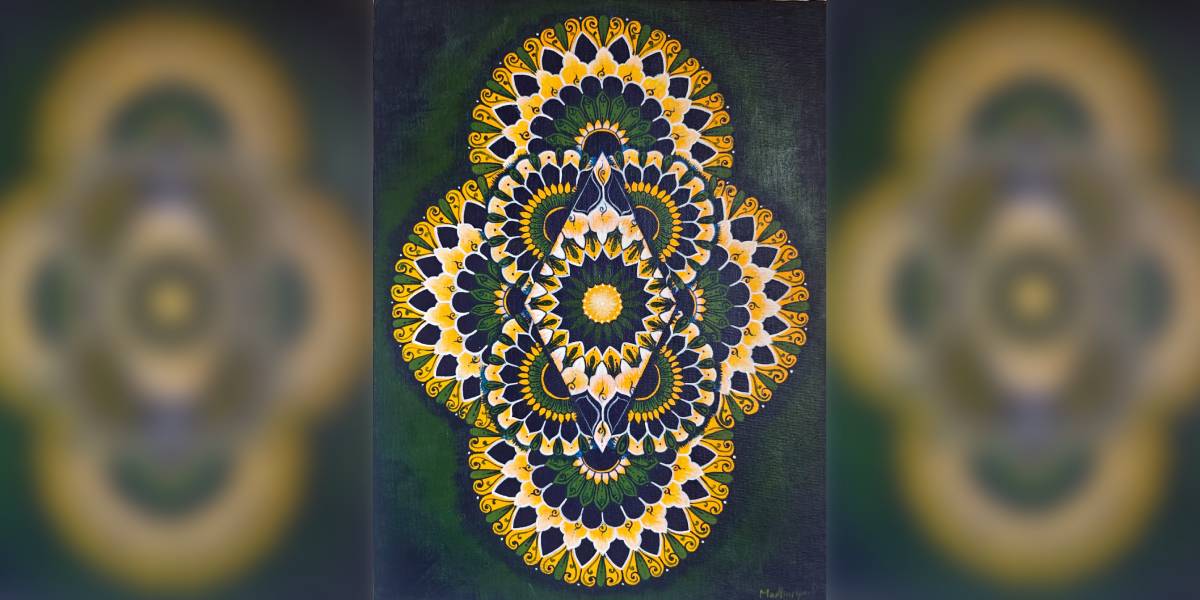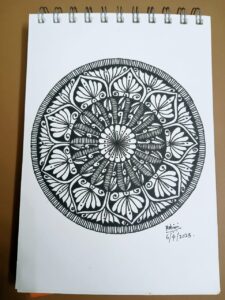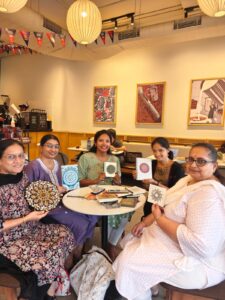Published May 16, 2025 | 9:32 AM ⚊ Updated May 16, 2025 | 9:32 AM

Mandala art is a geometric illustration style developed in Hindu and Buddhist cultures. It is also found in North American, Celtic and Islamic traditions. Pictured, a work by Madhurya Dwarkanath. (Supplied)
Synopsis: The Mandala Artists Collective will hold an exhibition in Bengaluru from 10 to 13 July, showcasing the works of more than 20 artists. The show will offer a glimpse into the different ways the art form can be interpreted.
Madhurya Dwarkanath’s journey into the world of mandala art is as fascinating as the entangled patterns she creates. Her deep connection with art started in her childhood, but it was in 2016 that she first did mandala art.
Initially, it began as a form of expression to overcome boredom after moving into a new city. She found herself drawn to the art form, and soon, mandalas became her therapeutic outlet.
In a journey marked by both personal and professional changes, Banashankari, Bengaluru-based Madhurya found herself moving from a job in an insurance company to working as a coordinator with an NGO. However, despite her success in these fields, her heart remained with art.
During the lockdown, she took the leap to pursue mandala art more seriously, conducting workshops and discovering the profound emotional benefits the art form provides. As she recalls, “What kept me intact is practicing mandala. I drew a lot of mandalas during those times, and that thought, that practice kept me going.”
Mandala art, known for its symmetry and hypnotic patterns, provides more than just a creative outlet; it offers a sense of peace and calm. “It gives a different kind of peace, and you’ll have a very calm mindset while doing this. People find themselves being calm and concentrated while drawing or even colouring,” says Madhurya.

A mandala artwork.
The therapeutic effects of mandala art are widely recognised, helping individuals find emotional release, balance, and healing.
Madhurya, who experienced immense personal loss, found comfort in the steady flow of lines and circles. She explains that drawing mandalas during the emotional turmoil of losing her father and experiencing a miscarriage helped her go through the deep grief.
While mandala art is Madhurya’s personal therapeutic space, it is also a platform for a growing community of like-minded artists. In 2019, she formed a small group of artists on Instagram, aimed at sharing mandala-related knowledge and fostering a collective space for exploration.
The pandemic interrupted this initial effort, but the desire to create a community never faded. It wasn’t until Madhurya participated in an exhibition in January 2025 that the idea of a mandala-focused collective was restarted.
“I realised we need a platform where we can showcase only mandala artworks,” she says. This realisation led to the formation of the Mandala Artists Collective, a space where artists could come together, share their unique mandala styles, and promote the therapeutic aspects of the art form.
Rohini Bharath, an important part of the collective, came into the picture when Madhurya pitched the idea of forming the group. “We met through Instagram, where we admired each other’s work. After interacting at an exhibition, we realised there was a shared vision between us, and that’s how the group was formed,” Madhurya recalls.
Together, they have grown the collective into an active community of 38 artists, with many more expressing interest.
Rohini’s support and shared enthusiasm played a key role in bringing the collective to life, as they try to give mandala artists a platform to display their work and explore the therapeutic aspects of their craft.
The Mandala Artists Collective has big plans for the future. Alongside workshops, which serve as a primary source of income for many of the artists, the collective aims to curate exhibitions and foster deeper connections within the mandala community.
An exhibition is scheduled for 10-13 July at the Indian Institute of World Culture, where more than 70 artworks from 20 to 30 artists will be displayed. The show will focus exclusively on mandala art, offering a glimpse into the different ways the art form can be interpreted.

Artists with their works.
What’s more, the collective has been a guiding light for aspiring mandala artists, with many newcomers seeking guidance and community. “We have received a lot of requests to join the group,” says Madhurya.
However, the collective remains selective, focusing on artists who are serious about pursuing Mandala art professionally, offering them a platform to grow and refine their skills.
As more and more people discover the therapeutic effects of mandala art, Madhurya and the Mandala Artists Collective continue to succeed. They are building not just a community of artists but a space where individuals can heal, express themselves, and share their journeys through the art of symmetry and design.
“Mandala is my freedom space,” says Madhurya. For many others, it has become a path to emotional well-being, personal growth, and a shared sense of purpose.
(Edited by Majnu Babu).
